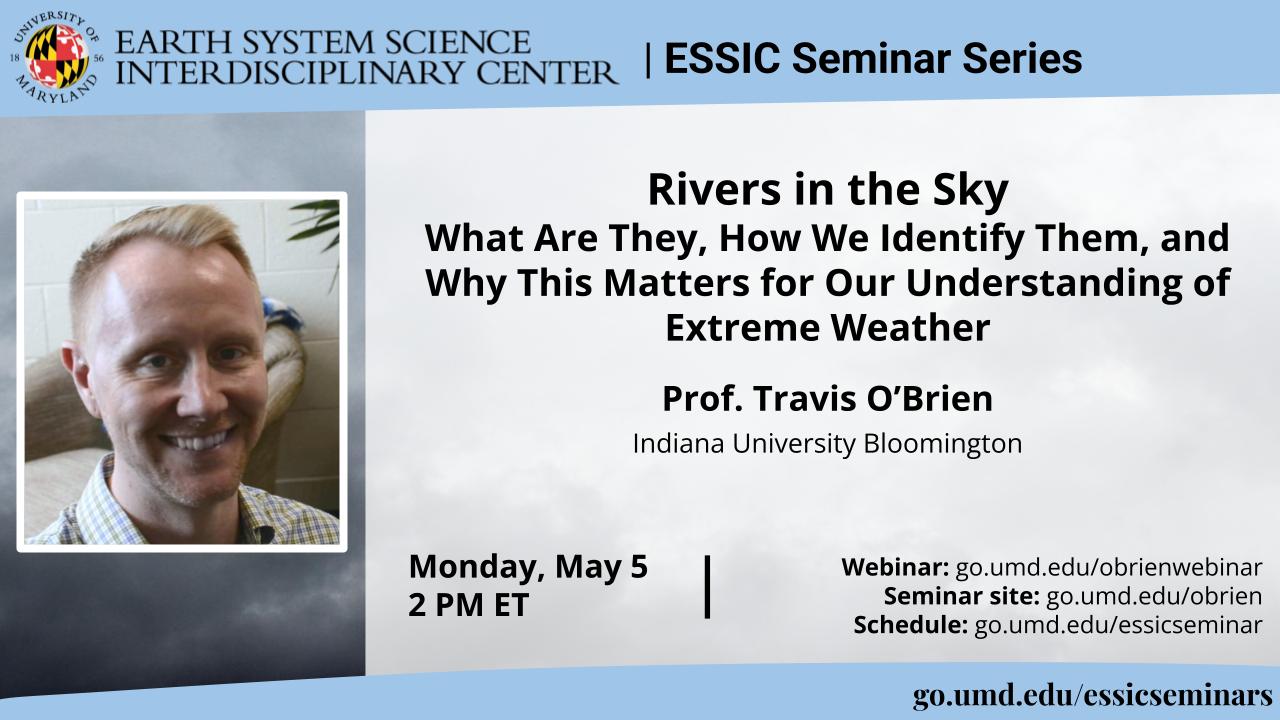
Rivers in the Sky: What Are They, How We Identify Them, and Why This Matters for Our Understanding of Extreme Weather
Prof. Travis O’Brien
Indiana University Bloomington
Monday May 5, 2025, 2 PM ET
Abstract:
Atmospheric rivers have gained increasing amounts of attention in the scientific literature and in popular media in the last couple decades. These narrow bands of intense water vapor transport are broadly viewed as a west coast phenomenon, with most of the literature focusing on atmospheric rivers (ARs) in western coastal regions: particularly the U.S. West Coast. The AR paradigm has proven incredibly useful for simplifying the communication of hazards associated with the complex meteorological conditions that give rise to ARs. Notable examples of this impact include increasingly widespread adoption of the Ralph et al. AR categorization scale as well as investment by the federal government in real-time reconnaissance of ARs to improve predictions.
The increased scientific attention on ARs has led to a proliferation of automated algorithms to identify them in weather and climate datasets. While these AR detection algorithms broadly agree on the identification of strong ARs, discrepancies in detecting weak and moderate ARs leads to a surprisingly large uncertainty in our understanding of the past and the future of these weather events. The Atmospheric River Tracking Method Intercomparison Project (ARTMIP) formed, as an ad hoc international collaboration, in 2017 with the goal of exploring and elucidating this uncertainty and its impacts on our scientific understanding of extremes in the past, present, and possible future climates. This presentation highlights recent results from among the nearly 30 papers that the ARTMIP project—and its associated datasets—has enabled: including some of the most robust findings (e.g., ARs occur worldwide, and ARs will likely become larger and more numerous in the future) as well as areas where future work is needed (e.g., uncertainty associated with AR detection swamps model uncertainty in climate change experiments; and different AR detection algorithms disagree on the seasonality of ARs in some regions).
These results, as well as the west-coast focus of most the AR literature, raise some fundamental questions: (1) are ARs in non-western-coastal regions the same phenomenon as western coastal ARs; and (2) given the major uncertainties associated with AR detection, are the different AR detection algorithms all detecting the same phenomenon? Results from two new studies provide strong evidence that (1) ARs in the eastern half of the United States are associated with longwave baroclinic waves like their western coastal counterparts, and (2) different AR detection algorithms all identify AR objects that are associated with longwave baroclinic waves. This implies that uncertainty associated with AR detection most likely stems from subtle interactions between algorithmic choices (e.g., how to apply thresholds to meteorological fields) and changes in the spatial structure of meteorological fields under climate change. This presentation concludes by discussing implications for detection of other weather phenomena and our broader understanding of extreme weather and climate change.
Biosketch:
Dr. Travis O’Brien has been an assistant professor in the Earth and Atmospheric Sciences Department at Indiana University Bloomington since 2020 and was previously a research scientist at Lawrence Berkeley National Lab. Research within Travis’ group focuses on understanding what controls weather and climate phenomena that impact human and natural systems. He and his group specialize in utilizing a combination of numerical models, novel data analysis techniques, and fundamental theory to form and test hypotheses about what controls the physical characteristics and occurrence of weather patterns. This research focuses on the broad questions of:
- What causes characteristics of different weather types to vary from year to year?
- How well do different modeling approaches simulate different weather types?
- How will anthropogenic climate change affect specific weather types?
Webinar:
Event site: https://go.umd.edu/obrien
Zoom Webinar: https://go.umd.edu/obrienwebinar
Zoom Meeting ID: 959 6386 9650
Zoom password: essic
US Toll: +13017158592
Global call-in numbers: https://umd.zoom.us/u/aMElEpvNu
For IT assistance:
Cazzy Medley: cazzy@umd.edu
Resources:
Seminar schedule & archive: https://go.umd.edu/essicseminar
Seminar Google calendar: https://go.umd.edu/essicseminarcalendar
Seminar recordings on Youtube: https://www.youtube.com/user/ESSICUMD

